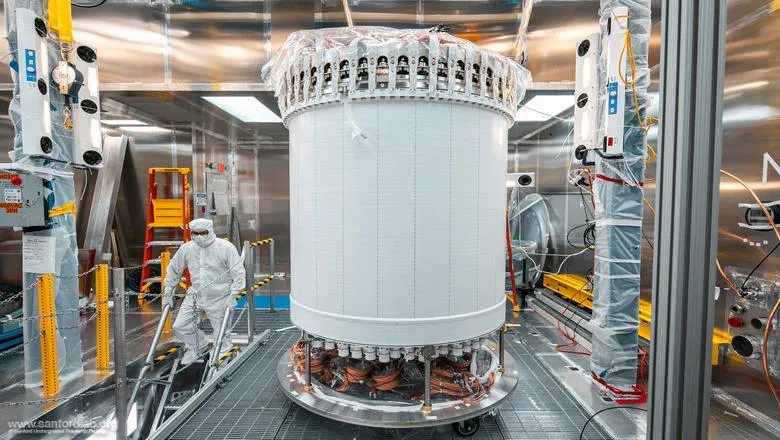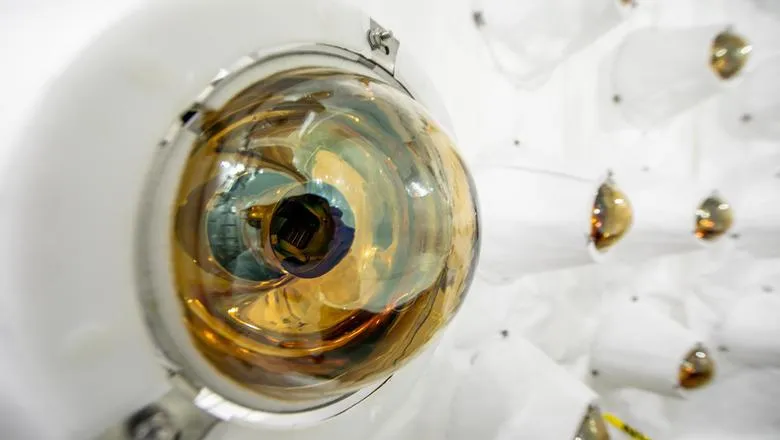The search for dark matter could help explain some of the most fundamental aspects of our universe, from how quickly galaxies rotate to how the structure of the universe came about... Because the stakes are so high, you need to have certainty in the quality of your analysis, and that your readings are robust."
Dr Jim Dobson
27 August 2024
King's physicists help set new record in search for dark matter
The new result is nearly five times better than anything previously published in the search for Weakly Interacting Massive Particles (WIMPs).

New results from one of the world’s most sensitive detectors have made a giant step in the search for a leading candidate of dark matter.
Drs Jim Dobson, Albert Baker and PhD candidate Catherine Lawes worked with a global team on the LUX-ZEPLIN (LZ) project, a dark matter detector run by the Lawrence Berkeley National Laboratory, to limit the area WIMPs could be hiding by a magnitude of five.
WIMPs are a key contender for dark matter, an unknown and unobserved form of matter that Einstein’s theory of general relativity suggests could make up as much of 85% of mass in the universe. These WIMPs are hypothesized to be particles which began their life in the early universe, and that weigh between the mass of one proton, a subatomic particle present in every atom, and a few thousand protons.
As the universe began to expand approximately 13.8 billion years ago, scientists believe that particles began to interact with each other to produce WIMPs or other candidates for dark matter. This hot mix of particles and radiation cooled as the universe expanded, leading to the particles and elements we can observe now, like hydrogen. By looking at patterns in the light left over from the Big Bang, cosmic background radiation, there is strong evidence that the missing mass of the universe comes in the form of particle dark matter. WIMPs would be a natural explanation for this but have so far evaded being detected directly by an experiment on earth.
LZ aims to detect WIMPs by measuring how these subatomic particles interact with a 10-tonne tank of liquid xenon a mile underneath the Sanford Underground Research Facility in South Dakota. By being so deep underground, the detector limits the impact of background radiation from cosmic rays coming from space.
LZ is the largest detector of its kind and is lined with specially built reflective panels and sensitive detectors which can detect the light and electrons which are emitted as the dark matter particles knock into xenon atoms. By collecting these small signals during interactions over a period of 280 days, the detector captured potential WIMP activity. Whilst no dark matter candidates were seen, the lack of a signal meant LZ could close the window on what the potential dark matter particle could be.

However, as the search for dark matter is one of science’s most pressing questions, the need to accurately say what is and what isn’t a WIMP interaction is paramount. Amongst other contributions, the team from King’s led the quality assurance of the analysis of data from LZ to ensure that no potential WIMP events were being thrown out or wrongly identified.
Dr Jim Dobson, Lecturer in Physics, and lead collaborator from King’s, said “The search for dark matter could help explain some of the most fundamental aspects of our universe, from how quickly galaxies rotate to how the structure of the universe came about. Accordingly, for rare search experiments like this one, a handful of events could tell you that you have found dark matter.
“Because the stakes are so high, you need to have certainty in the quality of your analysis, and that your readings are robust. That is how you build trust in the scientific community and ensure that when you finally find something, people stand up and take notice.”
If you think of the search for dark matter like looking for buried treasure, we’ve dug almost five times deeper than anyone else has in the past. That’s something you don’t do with a million shovels – you do it by inventing a new tool."
Professor Scott Kravitz, University of Texas at Austin and deputy physics coordinator at LZ
Commenting on what the new results reveal, Professor Scott Kravitz of the University of Texas at Austin and deputy physics coordinator at LZ, said “If you think of the search for dark matter like looking for buried treasure, we’ve dug almost five times deeper than anyone else has in the past. That’s something you don’t do with a million shovels – you do it by inventing a new tool.
“Our ability to search for dark matter is improving at a rate faster than Moore’s Law. If you look at an exponential curve, everything before now is nothing. Just wait until you see what comes next.”
LZ is an international project made up of 250 scientists, engineers and support staff and funded by the US, the UK through the Science and Technology Facilities Council, and other countries such as Portugal, South Korea, Australia and Switzerland.
The collaboration now hopes to improve on their design in a next-generation dark matter detector called XLZD, teaming up with collaborators from other xenon-based dark matter experiments to explore the remaining WIMP models and even more possible candidates of dark matter.
Original press release here.


